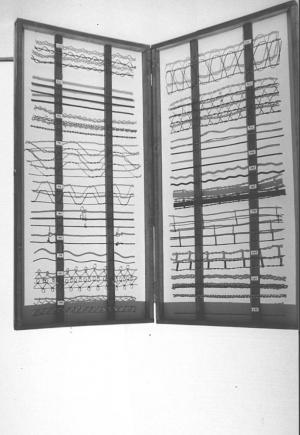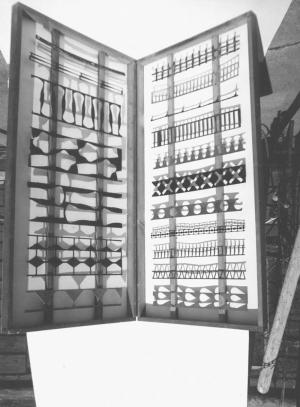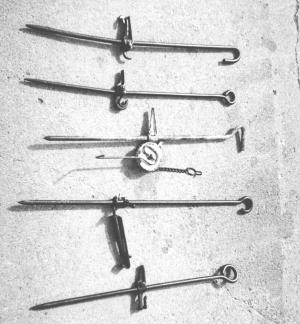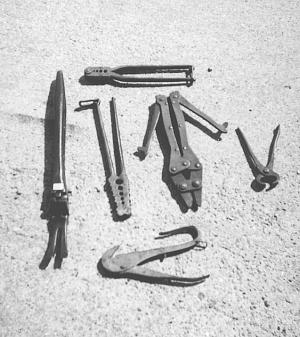He's Stuck On Barded Wire Collecting
When John Stohlmann, Jr., found some old barbed wire at his grandpa's farm in 1956, he had no idea it was the start of something big. Today, the Omaha, Neb., collector now has 1,965 types of barbed wire, 261 kinds of planter wire (for checking corn), and 880 wire-related tools. He also has 46 post hole diggers and the world's largest fence post and wire splice collections.
"My collection fills a 30 by 50-ft. building," Stohlmann says. "My uncle got interested in this also. We figured it would be an unusual and fun hobby."
His problem is that he likes and collects everything, including: diggers, stretchers, husking hooks, old limestone posts, ornamental gates, fence toppers, barriers, books, cattle guards, wire machines and even staples.
He's president of the Nebraska Barbed Wire Association and one of many collectors who gather regularly at shows to trade, buy and sell antique fence parts and tools (www.antiquebarbedwiresociety.com).
Two U.S. museums are dedicated to preserving the history of wire fencing: the Kansas Barbed Wire Museum in LaCrosse, Kansas, and the Devil's Rope Museum in McLean, Texas. There are collectors throughout the U.S., Canada and Europe.
Sometimes the collections are really unusual, such as canes made of barbed wire.
"Seventy to 80 years ago, if you bought a lot of barbed wire, they'd give you a barbed wire cane," Stohlmann explains. "Now those canes go for $1,000 or more."
The first U.S. barbed wire was patented in 1867, so there is a lot of history to tell. Stohlmann thinks it's important to share the information. It takes a couple hours for him to set up his collection displayed on white vinyl boards glued to plywood and 4 by 8-ft. angle iron frames for his posts and diggers. He regularly attends wire collector shows and threshing events.
"I'm the only crazy person into everything," Stohlmann says. "That's why I show a little of everything so people can see a variety and there's more to talk about."
Society members meet each October for a three-day session. Cost for antique barbed wire runs anywhere from 25 cents to $300 for an 18-in. piece. Tools run from $5 to $300.
For people interested in learning more, the society has books for sale and member Jim Goedert of Kearney, Neb., edits a newsletter every other month.
Stohlmann invites people interested in barbed wire to contact him. He's willing to put on presentations to groups.
Contact: FARM SHOW Followup, John Stohlmann, Jr., 6006 N. 168th St., Omaha, Neb. 68116 (ph 402 964-9797); Antique Barbed Wire Society (www.antiquebarbedwiresociety.com).

Click here to download page story appeared in.
Click here to read entire issue
He s Stuck On Barded Wire Collecting AG WORLD Ag World When John Stohlmann Jr found some old barbed wire at his grandpa s farm in 1956 he had no idea it was the start of something big Today the Omaha Neb collector now has 1 965 types of barbed wire 261 kinds of planter wire for checking corn and 880 wire-related tools He also has 46 post hole diggers and the world s largest fence post and wire splice collections My collection fills a 30 by 50-ft building Stohlmann says My uncle got interested in this also We figured it would be an unusual and fun hobby His problem is that he likes and collects everything including: diggers stretchers husking hooks old limestone posts ornamental gates fence toppers barriers books cattle guards wire machines and even staples He s president of the Nebraska Barbed Wire Association and one of many collectors who gather regularly at shows to trade buy and sell antique fence parts and tools www antiquebarbedwiresociety com Two U S museums are dedicated to preserving the history of wire fencing: the Kansas Barbed Wire Museum in LaCrosse Kansas and the Devil s Rope Museum in McLean Texas There are collectors throughout the U S Canada and Europe Sometimes the collections are really unusual such as canes made of barbed wire Seventy to 80 years ago if you bought a lot of barbed wire they d give you a barbed wire cane Stohlmann explains Now those canes go for $1 000 or more The first U S barbed wire was patented in 1867 so there is a lot of history to tell Stohlmann thinks it s important to share the information It takes a couple hours for him to set up his collection displayed on white vinyl boards glued to plywood and 4 by 8-ft angle iron frames for his posts and diggers He regularly attends wire collector shows and threshing events I m the only crazy person into everything Stohlmann says That s why I show a little of everything so people can see a variety and there s more to talk about Society members meet each October for a three-day session Cost for antique barbed wire runs anywhere from 25 cents to $300 for an 18-in piece Tools run from $5 to $300 For people interested in learning more the society has books for sale and member Jim Goedert of Kearney Neb edits a newsletter every other month Stohlmann invites people interested in barbed wire to contact him He s willing to put on presentations to groups Contact: FARM SHOW Followup John Stohlmann Jr 6006 N 168th St Omaha Neb 68116 ph 402 964-9797 ; Antique Barbed Wire Society www antiquebarbedwiresociety com
To read the rest of this story, download this issue below or click
here to register with your account number.










